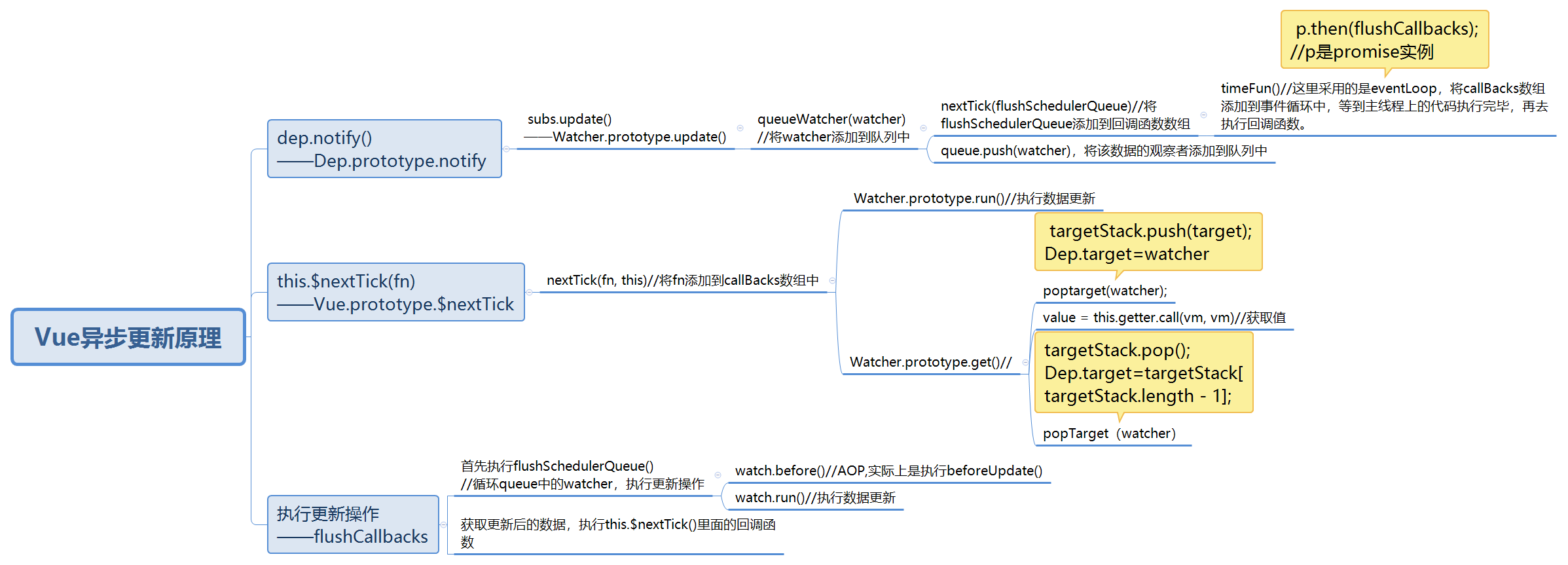源码如下所示,源码里主要是这 nextTick、timeFun、flushCallbacks 三个函数。
let pending=false;
let callBacks=[];//存放的是回调函数,存放的第一个回调函数是数据更新的回调函数
//调用this.$nextTick时执行的函数
function nextTick (cb, ctx) {
var _resolve;
callbacks.push(function () {
if (cb) {
try {
cb.call(ctx);
} catch (e) {
handleError(e, ctx, 'nextTick');
}
} else if (_resolve) {
_resolve(ctx);
}
});
//在数据首次修改时,pending为false,修改后,pending变成true
if (!pending) {
pending = true;
//在这里用到了事件循环
timerFunc();
}
// $flow-disable-line
if (!cb && typeof Promise !== 'undefined') {
return new Promise(function (resolve) {
_resolve = resolve;
})
}
}
//定义eventLoop函数
let timeFunc=null;
if (typeof Promise !== 'undefined' && isNative(Promise)) {
var p = Promise.resolve();
timerFunc = function () {
p.then(flushCallbacks);
if (isIOS) { setTimeout(noop); }
};
isUsingMicroTask = true;
} else if (!isIE && typeof MutationObserver !== 'undefined' && (
isNative(MutationObserver) ||
// PhantomJS and iOS 7.x
MutationObserver.toString() === '[object MutationObserverConstructor]'
)) {
var counter = 1;
var observer = new MutationObserver(flushCallbacks);
var textNode = document.createTextNode(String(counter));
observer.observe(textNode, {
characterData: true
});
timerFunc = function () {
counter = (counter + 1) % 2;
textNode.data = String(counter);
};
isUsingMicroTask = true;
} else if (typeof setImmediate !== 'undefined' && isNative(setImmediate)) {
timerFunc = function () {
setImmediate(flushCallbacks);
};
} else {
// Fallback to setTimeout.
timerFunc = function () {
setTimeout(flushCallbacks, 0);
};
}
//清空事件队列中的回调函数,第一个回调函数是flushSchedulerQueue ()
function flushCallbacks () {
pending = false;
var copies = callbacks.slice(0);
callbacks.length = 0;
for (var i = 0; i < copies.length; i++) {
copies[i]();
}
}
//flushSchedulerQueue的核心代码,执行数据更新操作
function flushSchedulerQueue () {
currentFlushTimestamp = getNow();
flushing = true;
var watcher, id;
queue.sort(function (a, b) { return a.id - b.id; });
for (index = 0; index < queue.length; index++) {
watcher = queue[index];
if (watcher.before) {
//调用beforeUpdate()钩子函数
watcher.before();
}
id = watcher.id;
has[id] = null;
//执行更新
watcher.run();
}
}
1
2
3
4
5
6
7
8
9
10
11
12
13
14
15
16
17
18
19
20
21
22
23
24
25
26
27
28
29
30
31
32
33
34
35
36
37
38
39
40
41
42
43
44
45
46
47
48
49
50
51
52
53
54
55
56
57
58
59
60
61
62
63
64
65
66
67
68
69
70
71
72
73
74
75
76
77
78
79
80
81
82
83
84
85
86
87
88
89
90
91
92
2
3
4
5
6
7
8
9
10
11
12
13
14
15
16
17
18
19
20
21
22
23
24
25
26
27
28
29
30
31
32
33
34
35
36
37
38
39
40
41
42
43
44
45
46
47
48
49
50
51
52
53
54
55
56
57
58
59
60
61
62
63
64
65
66
67
68
69
70
71
72
73
74
75
76
77
78
79
80
81
82
83
84
85
86
87
88
89
90
91
92
在下次DOM更新循环结束之后执行的延迟回调。nextTick 主要使用了宏任务和微任务。根据执行环境分别尝试采用
PromiseMutationObserversetImmediate- 如果以上都不行则采用
setTimeout
Vue的 nextTick 的实现原理总结如下
nextTick是Vue提供的一个全局的API,由于Vue的异步更新策略导致我们对数据的修改不会立马体现到都没变化上,此时如果想要立即获取更新后的dom的状态,就需要使用这个方法。Vue在更新dom时是异步执行的。只要监听到数据变化,Vue将开启一个队列,并缓冲在同一事件循环中发生的所有数据变更。如果同一个watcher被多次触发,只会被推入到队列中一次。这种在缓存时去重对于避免不必要的计算和dom操作是非常重要的。nextTick方法会在队列中加入一个回调函数,确保该函数在前面的dom操作完成后才调用。 用一张图可以很好的描述下这个过程。